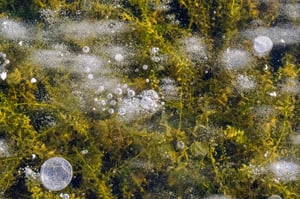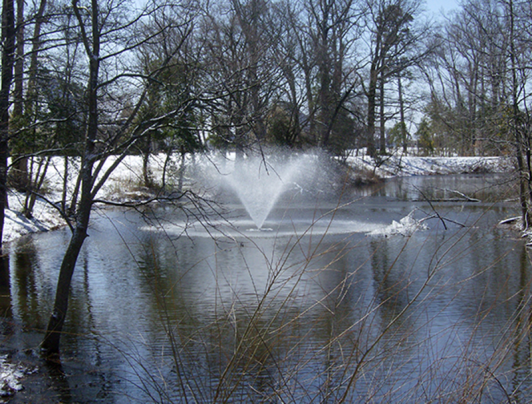Proper aeration and circulation are an important part of the health of your pond or lake all year round, and winter is certainly no exception. In fact, while there may be an excess of dissolved oxygen in the water as the temperature drops, unique problems can arise in areas where it is cold enough to freeze over the pond.
Why Aerate Your Pond in Winter
As the days grow shorter, varying types of algae and plants, which rely on sunlight to produce oxygen, will die off. This is especially true when there is a layer of ice on the water’s surface - further hindering the sunlight from reaching the necessary water depths.
Also, fall commonly loads a pond’s water with organic fertilizers, such as leaf litter, and while you will mostly see the symptoms of this loading occur in the spring and summer, in the winter months your pond begins attempting to digest these nutrients, which also depletes oxygen from the water. An aerated pond will help keep your fish healthy during this time.
Improve Water Oxygen Quality with Aeration
Aeration increases oxygen presence in the pond by churning the water, keeping it moving, and disrupting ice formation. This further creates more open water, attracting waterfowl and other wildlife, and serving as an escape path for bursts of toxic gasses created from the anoxic sediment below, which would otherwise be trapped under the ice.
A fountain can be successfully kept running through even the most bitter months of winter by coupling a bottom-based diffuser directly below the fountain. This will create a constant stream of air, which prevents the water from around the fountain from freezing.
Fountains and Aerators are a Great Choice for Winter Pond Management
Fountains and aerators serve somewhat as an insurance policy, much to protect the time and financial investment of your fish.
A great game plan to prepare for winter is properly maintaining your fountains and aerators throughout the year. Playing catch up? Pond King is here with expertly trained staff, and all the products you need to keep your pond in tip-top shape in every phase of Mother Nature.
Aerators and Freezing Water
How you handle an extended freeze if you have an aerator is really going to depend more on which type of aerator you have. If you have a bottom aerator, the best thing for your fish is to leave it running 24/7.
The deeper your pond, the truer this is.
But, if you have a surface aerator, regardless of your pond’s depth, you’ll be dealing with the same issues as if you had a fountain so read on for more information.
Fountains and Freezing Weather
If you have a fountain and you are looking at a weather forecast with an extended period of freezing weather, you may be wondering what to do with your fountain:
- Remove it until the temperatures warm up
- Run it 24/7 to prevent a solid layer of ice on my pond
- Run on and off and closely manage the process.

The problem with an extended freeze and fountains is that ice build up can damage the float and pumping chamber if not managed.
Of course, the thickness of ice matters. Obviously a thin layer that cracks easily poses little risk to a fountain. But if you are looking at several days in a row when the temperature is going to stay below 32 degrees, the safest thing to do for your fountain is to remove it from your pond and store it somewhere it won't freeze.
Do not just turn your fountain off and let it sit as this poses the greatest risk.
Can You Run a Pond Fountain All Day in Winter?
Running the fountain 24/7 can protect a fountain from ice buildup. The fountain will pull warmer water from below and keep an area clear around it.
However, in shallow ponds there isn’t much warmer water (thermal layer) and if you expose that warmer water to the cold air, it could actually expedite your pond freezing. So the deeper the pond the better chance of keeping the area clear.
If daytime temps will get above freezing and only below at night, in most cases, we'd recommend keeping the fountain on 24/7. But if you have a shallow pond with limited thermal layers of warm water, and you cannot remove the fountain, you could try managing the process.
Give Your Fountain a Rest Occasionally
Turning a fountain on and off periodically can also keep a fountain safe.
- Turn the fountain off and monitor the pond as it freezes. This will progress from the shoreline and move to the middle.
- As the ice gets close to the fountain, turn it on to open up an area then turn it off again. Do this repeatedly keeping ice away from the fountain and conserving the warmer water.
Remember, when it comes to weather, water and electrical devices, there are a lot of variables and no easy answers.
Contact Pond King for Winter Lake Management
If you are wondering how to manage your aerating device during a freeze, give our fisheries biologists a call or contact us and we'll help you figure out which option is best for you.
See y'all down at the pond.





